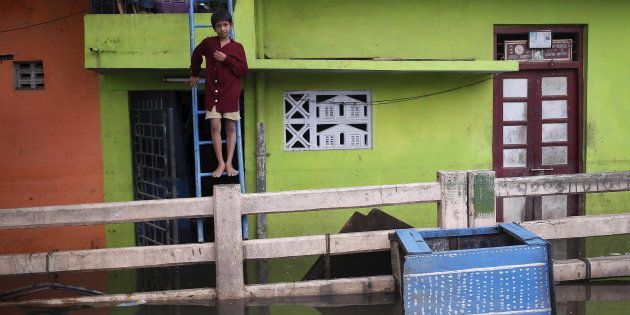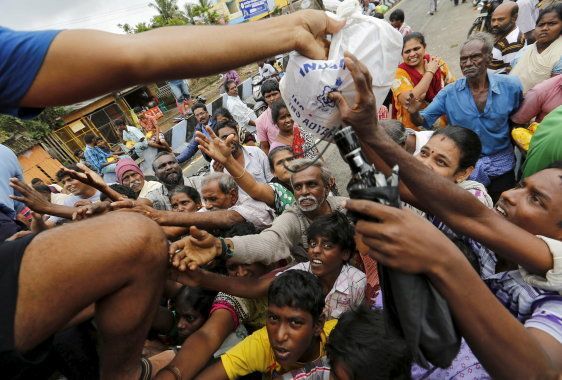
Chennai has been witnessing sporadic rainfall over the past couple of days, in what may seem like unseasonal rains. November-December, when Tamil Nadu usually experiences the north-east monsoon, is still a couple of months away, but every drizzle gets Chennaites worried now. The city has not quite forgotten the trauma it underwent in the first week of December last year and would hope the civic body has learnt its lessons.
The question is, has it?
Yes and no. Chennai corporation officials say its workers have been cleaning the storm water drains that run for a length of 1600 km through the city. "But the problem is that the desilting work is being done manually which ensures only partial cleaning. No machines are being used,'' says A Narayanan, social activist. "Moreover, these drains are very poorly designed, making them ineffective during floods.''
Aditya Krishna, who lives in the Kotturpuram, one of the worst affected parts of Chennai during the floods poses a counter-question, "How do you prepare for something which was largely a manmade disaster?''
Indeed, though nature did play its part with the city recording the highest rainfall in one hundred years (300 mm on December 1), the real villain of the story which led to Chennai going under was the decision to release 30,000 cusecs of water from the Chembarambakkam lake without warning and the encroachments into water bodies.

Eight months after the tragedy--in which 500 people died and 18 lakh people were displaced in northern Tamilnadu and Puducherry--nothing has been done to reclaim the lakes and the canals.
"The administration is complacent. They believe that since last year's rainfall was a once in a 100 years phenomenon, it won't repeat. There has been no initiative to clear the encroachments. That will cost Chennai dear once again,'' says MG Devasagayam, former bureaucrat and urban planning expert.
That the governments - in Chennai and New Delhi - are more happy blaming the elements for the mess was obvious in Union home secretary Rajiv Mehrishi's submission to the Parliamentary Standing committee on Home Affairs.
That the governments - in Chennai and New Delhi - are more happy blaming the elements for the mess was obvious in Union home secretary Rajiv Mehrishi's submission to the Parliamentary Standing committee on Home Affairs. The report said there cannot be preparation for a disaster like the Chennai floods which "occurs once in 100 years''. The secretary had contended that "the cost of preparing for the disaster would be disproportionately high''. His argument was dismissed by the Committee which asked the governments to bolster their disaster preparedness.
But the submission gives a sense of the thinking of the establishment. Which is why nothing has been done to desilt the water bodies or to ensure that construction debris is not dumped into them. Wetlands over the years, have disappeared with official approval. According to urban development ministry records, some 5000 hectares of swamp have been converted into concrete in the IT corridor in south Chennai over the past decade and a half.

"Take for example, the Villivakkam lake. From 300 acres, it had shrunk to 50 acres. Now with dumping of Chennai Metro Rail work debris into the lake, it has further shrunk to 19 acres. SIDCO Nagar is in fact, built on the Villivakkam lake bed,'' says Chandramohan, activist with Arappor Iyakkam, a civil society initiative.
In July, Arappor Iyakkam with 150 volunteers conducted a social audit of the city's waterways and in four areas - Villivakkam, Pallavaram, Pallikaranai and Moulivakkam - which were badly affected in December 2015. The audit concluded that, "Chennai's water bodies are in no state to handle the rains - they are filled with garbage and plastic or covered in silt and water hyacinth or worst of all, completely encroached or choked with debris.''
That 2016 is no better than 2015 should worry Chennai. Especially since the city officials and politicians are set to get into election mode with the dates for election to the Chennai municipal corporation and other local bodies likely to be announced soon.
Activists claim the AIADMK does not like to hear the word 'floods' as it knows it did not cover itself with glory with its inept handling of the situation last time. So corporation officials are merely going through the motions of a clean-up. The only silver lining is that senior IAS officer D Karthikeyan, who has headed the corporation twice before, is once again at the helm of affairs and his experience should help.
But Chennai is bursting with questions. It wants to know if the Chennai airport will once again go under water and stay shut like it did for nearly a week last year or has the problem been fixed.
But Chennai is bursting with questions. It wants to know if the Chennai airport will once again go under water and stay shut like it did for nearly a week last year or has the problem been fixed. Out of 3600 water bodies in 1974, there are 3000 now on paper but a majority of them are badly encroached. The waterway links between different water bodies to naturally take the water into the sea have all disappeared, under constructions.
"Till two weeks back, the PWD officials we spoke to said we cannot do anything as we have no funds. We want to know what happened to all the money that came in after the floods last year? What happened to the Cooum river revival project of September 2015 for which Rs 2000 crore was sanctioned?'' asks Chandramohan.
On Sunday, a public hearing `Kelu Chennai Kelu' (Listen Chennai Listen) will be held at Vallavur Kottam in Chennai where Arappor Iyakkam wants the public to voice their concerns and grievances so that the voice of Chennai can be heard. It hopes the MLAs and Chennai corporation and PWD officials who have been invited, make an appearance so that it is a two-way conversation.
It is an attempt by Chennai to keep itself safe or at least be well-prepared for any eventuality and to compel the administration to put in place measures to ensure against a repeat of 2015.
The wet Chennai of December 2015, wants to be home and dry this monsoon.